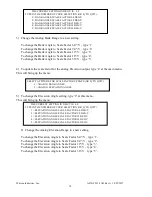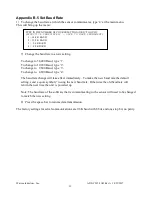
Watson Industries, Inc.
ADS-C232-3AD Rev A 10/25/2017
4
Mounting
The unit has three 0.12” diameter mounting holes for using three # 4 (or 3 mm) screws. To
avoid distortion, the unit must be attached to a clean, flat surface, and the fasteners must be
tightened evenly.
Environment:
Avoid mounting sites that are subject to significant temperature variation over the duration of the
test. Temperature variation will induce significant rate sensor bias drift, which will reflect in poor
attitude accuracy.
For shipboard applications, install the sensor near the center of gravity. For all applications, it is
preferable to install the device where linear dynamic effects are minimized.
Power
This unit has an internal regulator to allow operation over a wide voltage input range. Best
operation is obtained at 12 or +24 VDC level, although operation is fully satisfactory down
to +8 VDC and up to +45 VDC. The power ground is already connected internally to the signal
ground. Do not connect the ground wires externally.
Power consumption of the unit is about
0.5W. Internal capacitors are provided to remove a reasonable level of power line noise, however,
capacitors should be added for long power line wiring or if noise is induced from other loads on the
circuit.
Theory of Operation
In order to obtain an accurate signal in both the short-term and in the long-term, the Vertical
Reference relies upon a Watson Industries angular rate sensor (ARS) combined with solid-state
accelerometers. The position output is generated by integrating the angular rate output. This signal
is compared with the output from the accelerometer and the resultant error signal is passed through
a long time constant filter and fed back as a bias to the rate sensor. The system is damped by
sending a portion of the error directly to the position integrator. By using a long time constant, the
effect of the short-term errors in the accelerometer is minimized. Thus, the adverse effects of
inertia, damping and short-term lateral accelerations on the pendulum essentially do not show up
on the vertical reference output. See Figure 1 for system overview.
Figure 1
The solid-state angular rate sensor used here works on the basic principle of detecting coriolis
forces. These forces are generated when a moving particle is rotated. To use the coriolis effect to
detect angular rotation, a solid structure is forced to vibrate normally at its resonant frequency. The
vibration provides the structure with a linear velocity component. When the structure is rotated, the
coriolis forces cause the vibration motion of the structure to be coupled to another vibration mode



















